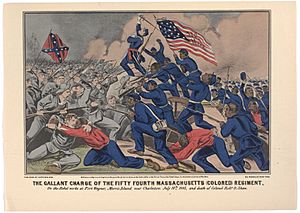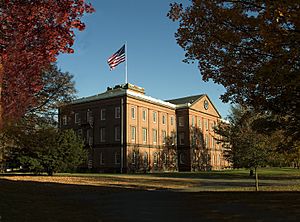Massachusetts in the American Civil War facts for kids
Massachusetts played a very important part in the events leading up to and during the American Civil War (1861-1865). In the 1830s, Massachusetts was a leader in the movement to end slavery, called abolitionism. This movement helped create more tension between the North and South, which was one of the main reasons for the war.
Many politicians from Massachusetts also spoke out against slavery, adding to the national disagreements. The state was mostly controlled by the Republican Party. It was also home to many Radical Republican leaders. These leaders wanted harsh treatment for slave owners and, later, for the former leaders of the Confederate States of America.
Once the war started, Massachusetts strongly supported the North. The state sent 159,165 men to fight in the Union Army and the Union Navy. One of the most famous units from Massachusetts was the 54th Massachusetts Volunteer Infantry. This was the first army group made up of African American soldiers, though they were led by white officers. Important generals from Massachusetts included Benjamin F. Butler, Joseph Hooker, and Edwin V. Sumner.
Massachusetts was also a major center for factories and making things. This meant it could produce a lot of weapons and supplies for the war. The most important place for weapons was the Springfield Armory. The state also helped with relief efforts. Many leaders in nursing and soldier aid organizations were from Massachusetts. These included Dorothea Dix, who started the Army Nurses Bureau, and Clara Barton, who later founded the American Red Cross.
Contents
Massachusetts and the Road to War
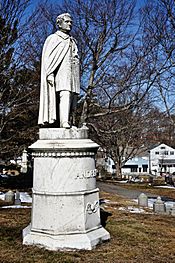
Massachusetts played a big role in the events that led to the American Civil War. This was especially true because of its strong anti-slavery movement. People in Massachusetts who wanted to end slavery tried to change public opinion. They also put pressure on the United States Congress to make slavery illegal.
In 1831, William Lloyd Garrison (1805-1879) from Boston started publishing an anti-slavery newspaper called The Liberator. He also founded the New England Anti-Slavery Society. Garrison became one of the most important writers and abolitionists in the country. His strong words caused angry reactions in both the North and the South. This made the tensions between the regions much worse before the war.
By the late 1850s, the anti-slavery Republican Party became very powerful in many northeastern states. Important Republican leaders from Massachusetts included U.S. Senators Charles Sumner and Henry Wilson. They shared Garrison's views and made the divide between North and South even deeper.
In 1856, Senator Sumner gave a very critical speech in the United States Senate. He insulted pro-slavery politicians from the South. Later, Representative Preston Brooks from South Carolina attacked Senator Sumner on the Senate floor. Brooks beat him severely with a cane. Sumner was so badly hurt that he could not return to his Senate duties for several months. This event made the tensions between North and South even higher.
By 1860, Republicans controlled the Governor's office and the state's government. In the 1860 presidential election, most Massachusetts voters supported Abraham Lincoln and the Republican Party. Support for the Republican Party grew even more during the war.
The most important political figure in Massachusetts during the war was Governor John Albion Andrew. He was a strong Republican who worked hard to support the war effort. Massachusetts voters re-elected him every year during the war by large numbers.
Massachusetts Soldiers and Recruitment
Massachusetts sent a total of 159,165 men to serve in the war. Most of these, 133,002, served in the Union army. The rest, 26,163, served in the navy. The army units from Massachusetts included many groups of infantry (foot soldiers), cavalry (soldiers on horseback), and artillery (soldiers who use cannons).
The Minutemen of '61
Governor Andrew became governor in January 1861, just two weeks after South Carolina left the Union. He believed war was coming soon. So, he quickly prepared the state's citizen soldiers (militia) for duty. On April 15, 1861, Andrew received a message from Washington. It asked for 1,500 men from Massachusetts to serve for ninety days. The very next day, several groups of soldiers were ready in Boston. By the end of that day, three regiments were prepared to go to Washington.
On April 19, 1861, the 6th Massachusetts was passing through Baltimore. A mob that supported the South attacked them. These soldiers became the first volunteer troops to suffer injuries in the war. The 6th Massachusetts was also the first volunteer regiment to reach Washington, D.C. after President Lincoln asked for troops. Lincoln was waiting for more regiments, but none arrived for several days. When he saw the 6th Massachusetts on April 24, Lincoln told them, "I don't believe there is any North...You are the only Northern realities."
The 6th Massachusetts reached Washington on April 19. This date was the anniversary of the Battles of Lexington and Concord, which started the American Revolutionary War. Because of this, the first militia units to leave Massachusetts were called "The Minutemen of '61."
Recruiting Three-Year Soldiers
After the first burst of excitement, the state government had to keep finding thousands of soldiers. Most of these troops had to serve for three years. Recruiting offices opened in almost every town. In 1861, Massachusetts found more recruits than needed. However, by the summer of 1862, fewer people were joining. So, Governor Andrew started a system where each city and town had a goal for how many recruits they should find. This encouraged local leaders, and more people enlisted.
The 54th Massachusetts Infantry
One of the most famous regiments from Massachusetts was the 54th Massachusetts Infantry. This was the first regiment in the Union army made up of African-American soldiers. White officers led them. After the Emancipation Proclamation took effect on January 1, 1863, Governor Andrew saw a chance for Massachusetts to lead in recruiting African-American soldiers.
After getting permission from President Lincoln, Andrew, along with black abolitionist Frederick Douglass, recruited two regiments of African American soldiers. These were the 54th and the 55th Massachusetts Infantries.
The 54th regiment received a lot of attention because it was the first of its kind. To make sure this experiment succeeded, Andrew asked for money and support from many rich families in Boston. He gained their support by offering the regiment's command to Robert Gould Shaw. Shaw was the son of important Bostonians. The 54th Massachusetts became famous for their brave attack on Battery Wagner in Charleston Harbor. During this attack, Col. Shaw was killed. The story of the 54th Massachusetts was made into the 1989 movie Glory.
Important Generals from Massachusetts

Generals from Massachusetts led several army groups. Some even commanded the main Union army, the Army of the Potomac.
One of the most well-known generals from Massachusetts was Maj. Gen. Joseph Hooker. He was born in Hadley, Massachusetts and went to the United States Military Academy (West Point). He fought in the Mexican–American War. When the Civil War began, he quickly rose through the ranks. He commanded the I Corps at the Battle of Antietam. Later, he was put in charge of the Army of the Potomac. He was good at making his army feel strong again by improving supplies. However, he struggled to lead the army in battle. His slow actions during the Battle of Chancellorsville led him to step down from command. He was then sent to fight in western campaigns and did well at the Battle of Lookout Mountain.
Maj. Gen. Nathaniel P. Banks, a former governor of Massachusetts, was one of the first men President Lincoln made a major general. In 1861, Banks commanded the Department of the Shenandoah. In May 1862, he was outsmarted by Stonewall Jackson and had to leave the Shenandoah Valley. He later led the successful Siege of Port Hudson in 1863. However, a difficult campaign in 1864 ended his time leading troops in the field.
Another important general from Massachusetts was Maj. Gen. Edwin Vose Sumner. Born in 1797, he was the oldest general officer leading troops in battle on either side of the war. He had served in the army for many years. Sumner commanded the II Corps during the Maryland Campaign. He died in March 1863.
Other notable generals from Massachusetts included Maj. Gen. Darius Couch and Maj. Gen. John G. Barnard, who helped organize the defenses of Washington, DC.
War Supplies and Factories
The North's advanced factories and industries were a big reason for the Union's victory. Massachusetts, especially the Springfield Armory, was very important in providing weapons and equipment for the Union army.
At the start of the war, the Springfield Armory was one of only two federal armories in the country. The other was the Harpers Ferry Armory. After the attack on Fort Sumter, Governor Andrew urged the Secretary of War to close the Harpers Ferry Armory (which was in Confederate territory). He wanted all money to go to increasing production at the Springfield Armory.
The Springfield Armory made the main weapon for Union foot soldiers during the war: the Springfield rifled musket. By the end of the war, nearly 1.5 million of these rifles had been made by the armory and other companies.
Another key place for war supplies was the Watertown Arsenal. It produced ammunition, gun carriages, and leather military gear. Private companies like Smith & Wesson also had big contracts with the U.S. government. The Ames Manufacturing Company in Chicopee became a top supplier of swords, small arms, and cannons.
Even though Massachusetts was known for shipbuilding before the war, many companies were slow to use new technology. Only a few Massachusetts shipbuilders got government contracts to build new iron-clad, steam-powered warships. These companies, like City Point Works and Atlantic Iron Works in Boston, had invested in iron and machine technology earlier. They built ships called Passaic class monitors during the war. The Boston Navy Yard also built several smaller gunboats.
Help and Relief Organizations
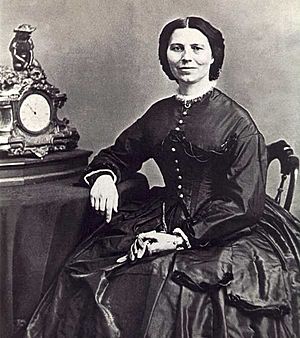
Several important leaders of soldier aid and relief groups came from Massachusetts. One was Dorothea Dix. Before the war, she traveled across the country helping people who were poor or had mental illnesses. After the war started, she convinced the U.S. Army to create a Women's Nursing Bureau in April 1861. She became the first woman to lead a federal government office.
Even though army officials were unsure about using female nurses, Dix recruited many women who had been volunteering on their own. One of her biggest challenges was showing that women could work just as well as men in army hospitals. Dix was known for turning away nurses who were too young or pretty. She believed that patients and doctors would not take them seriously. Despite these challenges, Dix successfully placed female nurses in hospitals throughout the North.
Henry Whitney Bellows took a different approach. He started a civilian organization of nurses separate from the U.S. Army. Bellows founded the United States Sanitary Commission and was its only president. He was an important minister from Boston. In May 1861, Bellows went to Washington leading a group of doctors. His goal was to convince the government to create a civilian group to help the Army Medical Bureau. The Sanitary Commission, started by President Lincoln on June 13, 1861, provided nurses (mostly women) with medical supplies. It also organized hospital ships and homes for soldiers.
Clara Barton, a former teacher from Oxford, Massachusetts, started her own relief effort. In the summer of 1861, there was a shortage of food and medicine for the Union army. She began buying and giving supplies to wounded soldiers in Washington herself. Barton later moved her efforts to the battlefields. She was allowed to go through army lines and helped the wounded in many battles. She soon became known as the "Angel of the Battlefield." She became famous, and high-ranking army surgeons asked for her help in their field hospitals.
After the War: Reconstruction
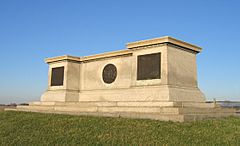
In total, 12,976 soldiers from Massachusetts died during the war. This was about eight percent of those who joined the army. After the war, groups like the Grand Army of the Republic (GAR) were formed to help veterans, widows, and orphans. Massachusetts was the first state to create a statewide Woman's Relief Corps, a women's group that helped the GAR, in 1879.
With the war over, Governor Andrew decided not to run for re-election in September 1865. Even without him, the Republican Party in Massachusetts became stronger than ever after the war. The Democratic Party almost disappeared in the state for about ten years because they had been against the war. This political change especially affected the growing Irish community in Boston, who had supported the Democratic Party. They had little political power for decades.
After the war, Senators Sumner and Wilson, who had been against slavery, became strong supporters of "Radical Reconstruction" of the South. They wanted civil rights for African Americans and harsh treatment for former Confederates.
For a while, the Radical Republicans made progress with their big reform plans. In 1865, Massachusetts state lawmakers passed the first law in the nation to fully integrate (mix) schools. At the national level, Sumner worked with Representative Thaddeus Stevens to pass the Civil Rights Act of 1866. They also helped pass the 13th, 14th, and 15th Amendments to the U.S. Constitution. These amendments outlawed slavery and gave more citizenship rights to former slaves.
However, by 1867, many people across the country started to oppose the Radical Republicans and their big civil rights programs. They became less popular, even in Massachusetts. By the 1870s, the Radical Republicans lost power, and Reconstruction became more moderate.
After the Civil War, Massachusetts changed. It was no longer the main center for big reform movements like it had been before the war. Growing industries, partly because of the war, created a new culture focused on competition and money.
In 1869, Boston hosted the National Peace Jubilee. This was a huge celebration to honor veterans and celebrate the return of peace. It was held in a giant arena built just for the event in Boston's Back Bay neighborhood. The event lasted five days and featured a chorus of nearly 11,000 singers and an orchestra of more than 500 musicians. It was the largest musical gathering on the continent at that time.
|
See also
 In Spanish: Massachusetts en la guerra de Secesión para niños
In Spanish: Massachusetts en la guerra de Secesión para niños



